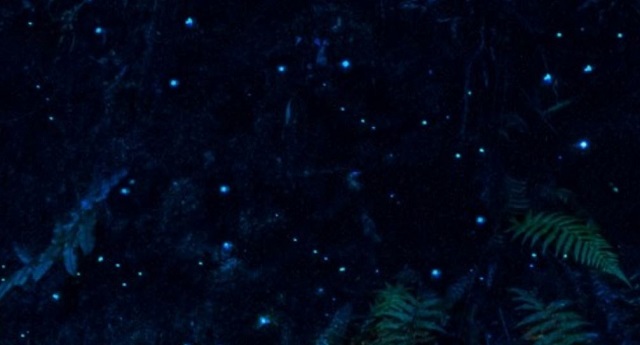Lavers Hill - Melba Gully Glow Worm Walk


Take your torch and explore the natural beauty of glow-worms by night at the Melba Gully area.
A visual spectacular - Despite their name, glow worms aren't worms. They are the larvae of fly-like insects called fungus gnats. Glow worms are common in damp, dark places, and in Melba Gully are often found on soil banks with overhanging ledges.
In the wetter parts of the Otway Ranges like Melba Gully, colonies of these glowing larvae put on a light show, a visual spectacular best appreciated at night.
Lighting Up - The end of the abdomen is luminous. The light is emitted from tiny tubes (malpighian tubules) which open into the gut of the larvae and are visible through transparent skin at the end of the body (the last segment of the abdomen). The light will 'go out' if the glow worm is disturbed, for example by noise or direct torchlight, so please tread quietly and don't touch!
Life cycle - The adult fungus gnat lays up to eighty eggs which hatch after 2-3 weeks. The larvae (glow worms) grow for up to nine months, after which they pupate. The pupa lasts nine days before the adult stage is reached.
The adult fungus gnat is about 1.5cm long, nocturnal (active at night), sluggish and harmless. It lives for a short period (48 to 72 hours) and makes a buzzing noise when in flight.
The fly also has an uncontrollable light, the female being brighter than the male until after mating - when she becomes terribly dull and boring!
Please do not touch or shine torches at the glow worms.
Silken retreats - The larvae build retreats in soil banks by producing threads of silk. They attach sticky beads or droplets to the threads, giving them a necklace appearance.
Some 5cm long, the threads trap tiny insects which are attracted by the glowing larvae.
The glow worm "reels" in the threads to devour its prey, hence the common reference to these silk traps as fishing lines.
Glow worms like wet and warm environments and the most likely time of the year to find them is during the warmer months of the year, between December to March but it is possible to see them most of the year although the display may be less impressive at these times.
How to get there
Follow the Great Ocean Road westwards from Lavers Hill for about 3km. The turn-off to Melba Gully is well sign posted. Drive for 1.5km along Melba Gully Road to the campsite where there are toilet facilities (without lights so bring a torch).
Madsen's Track Nature Walk at Melba Gully, which starts at the picnic area, is an easy 1.5km, 35 minute loop walk through a world of ancient, mossy trees and cool fern gullies.
To see the glow worms, it will be a night walk. The glow worms can usually be seen on the soil banks beside the track within a short distance along the trail from the picnic area and so you don't need to do the whole trail.
Places to See Glow Worms in the Otways
There are four places to see glow worms in the Otways. They are:
- Lake Elizabeth (near Forrest, 89km from Geelong)
- Kennett River (108km from Geelong)
- Melba Gully (near Lavers Hill, 135km from Geelong)
- Maits Rest (near Apollo Bay, 138km from Geelong)
Glow Worm Facts
Glow-Worms are not worms but rather the larvae of fly like insects called fungus gnats.
Tips on how to help protect Glow-Worms. As glow-worms prey on small insects, it is best not to wear insect repellent and to refrain from smoking or lighting fires in the 'Glow-Worm's' environment.
Larvae produce threads of sticky silk, their glow attracts prey which are then ensnared by the sticky threads.
The light "goes out" if disturbed in any way, For example: torch light or noise will turn out the light for up to 15 minutes.
Life Cycle. The adult Fungus Gnat lays up to eighty eggs, which hatch after 2-3 weeks. The larvae (Glow-Worms) grow over a period for up to nine months, they pupate for nine days after which the adult stage is reached. Only about 1.5 cm long in length, nocturnal, sluggish and harmless, the adult Fungus Gnat lives for only a short period (48 to 72 hours). When in flight they make a buzzing noise.
The adult fly has an uncontrollable light, with the female being brighter than the male until fertilised.
Where does the light come from? The end of the abdomen is luminous. The light is actually emitted from tiny tubes (malpighian tubules) which open into the gut of the larvae and are visible through transparent skin at the end of its body.
Glow-Worms are very shy! Please look, but don't touch. Glow-Worms are sensitive to disturbance and will 'switch off' their lights and retreat into a crack if they or their snares are touched.
Tips on how to help protect Glow-Worms. Glow-worms are nocturnal and rely on sunlight to set their daily rhythm. Shining torches on the insects signals them to 'switch off' their bioluminescence. To get the most out of a Glow-Worm display, make sure your torchlight is directed towards the ground.
Glow-Worms are found in dark damp places, often on soil banks with overhanging ledges.
Tips on how to help protect Glow-Worms. As well as residing in caves and under rocky overhangs, Glow-Worms can also be found along creek embankments and beside walking tracks. For this reason it is important to remain on designated walking tracks to prevent stepping on them.
Many thousands may live in large colonies, giving a spectacular effect.
Location
Melba Gully Road, Lavers Hill 3238 View Map
Web Links
→ Melba Gully (Great Otway National Park)








